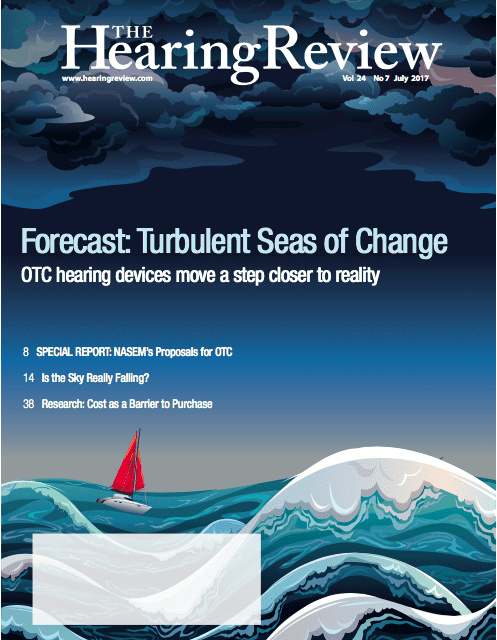Staff Standpoint | July 2017 Hearing Review
This month’s cover is meant to depict the turmoil that our industry finds itself in, as disruptive technology threatens to change some long-standing rules about hearing aid distribution and over-the-counter (OTC) hearing aids move a step closer to reality. But I admit it may be a bit overly dramatic. That’s because people have been getting hearing aids in all kinds of ways for decades. It should be pointed out that mail-order hearing aids have been around for almost a half-century (Lloyds was established in the 1970s), and Internet hearing aids have been available for purchase since at least the early 1990s. Likewise, Big Box retailers like Costco and Sam’s Club have created new options for consumers seeking professional hearing help; CVS Pharmacy and other players continue to enter and change the landscape of hearing healthcare, just as they continue to change healthcare in general. And hearing care dispensing offices are still competing well.
However, we are definitely facing some more major changes. In June, the Over the Counter Hearing Aid Act of 2017, which was bundled as part of the larger Medical Device User Fee Amendments (MDUFA) legislation, moved out of committee and will now be up for action by Congress. The bill largely mirrors legislation introduced by Senators Warren and Grassley in late 2016, and requires the FDA to propose a rule that would establish an OTC hearing aid category for adults with perceived mild-to-moderate hearing loss within 3 years of passage of the legislation, and finalize a rule within 180 days after the close of the comment period. Before passage of the MDUFA package, David McKinley (R-WV) spoke passionately during the House Energy & Labor Committee mark-up on June 7 about an amendment that would require people to seek professional assistance. Although Rep McKinley supports the OTC Hearing Aid Act, he says people should not buy a hearing aid without any prior screening or exam by a hearing care professional. As a cochlear implant user who lost his hearing as an adult, he testified that this would be an “untreatment” which could result in people ignoring underlying conditions or damaging their hearing through over-amplification. Former Energy and Commerce Chairman Fred Upton (R-MI), Mike Doyle (D-PA), and Bobby Rush (D-IL) also spoke in support of Rep McKinley’s concerns. However, the amendment was ultimately withdrawn. (You can view their remarks and the discussion about the amendment at goo.gl/pCGP8o.)
The Special Report on p 8 in this edition of Hearing Review looks at possible regulations for OTC hearing aids as envisioned by the National Academies of Sciences, Engineering, and Medicine (NASEM) Committee on Accessible and Affordable Hearing Health Care. While most professionals and organizations support efforts to increase the accessibility and affordability of hearing aids, there remains considerable debate about the overall scope/cause of the under-utilization of hearing aids (see Douglas Beck’s interview with Amyn Amlani on p 38), the severity of loss an OTC device should address, hearing assessment and labeling requirements, and if the new FDA medical device classification should meet the same safety and efficacy standards required of current hearing aids. It’s a complex issue fraught with controversy, as our Special Report points out. For example, the Hearing Industries Association (HIA) is urging FDA to limit OTC hearing aids to mild losses only, and to finalize its 2013 draft Personal Sound Amplification Products (PSAP) Guidance document to make clear that unregulated PSAPs cannot be marketed to address hearing loss; HIA says that those with mild hearing loss who seek a self-directed solution could instead have the option to purchase an OTC hearing device, once approved by FDA, rather than an unregulated PSAP or other consumer product.
One thing appears fairly certain: there will be a new FDA classification for OTC hearing aids—whether you like it or not. It should be emphasized that the NASEM report and the ensuing discussions, while extremely important and enlightening, are not part of the FDA’s formal rule-making process. The FDA’s stated mission is “to protect the public health by ensuring the safety, efficacy, and security of human and veterinary drugs, biological products, and medical devices; and by ensuring the safety of our nation’s food supply, cosmetics, and products that emit radiation.” So it justifiably views the world with a distinctly different prism. And, for now, how many of the NASEM Committee’s recommendations are used in the development of a future OTC hearing aid category is anyone’s guess.
Citation for this article: Strom KE. Some turbulent seas ahead…Hearing Review. 2017;24(7):6.







